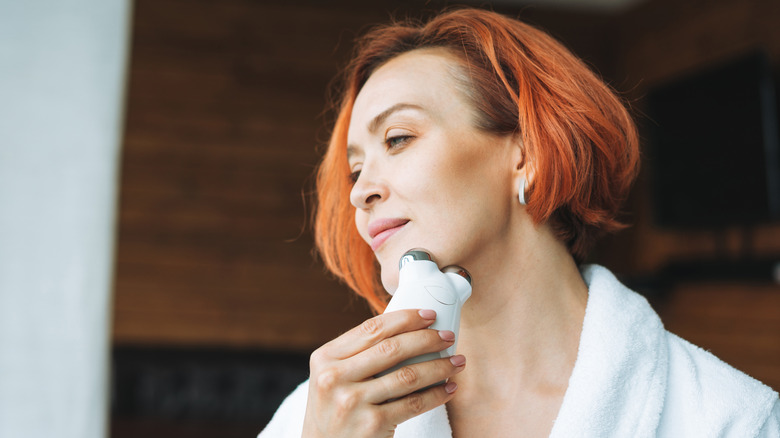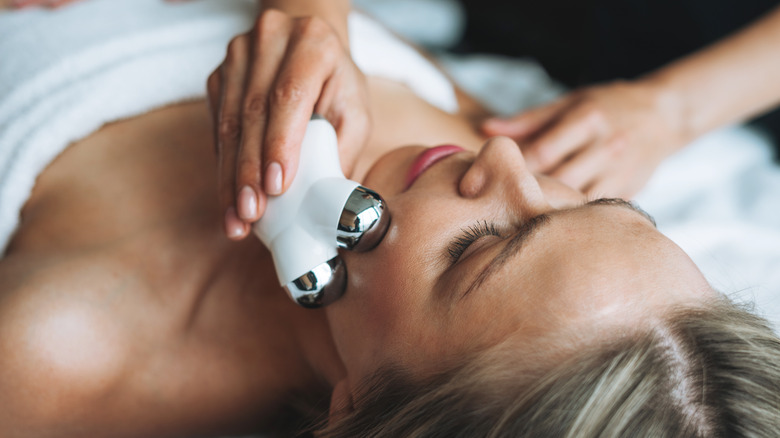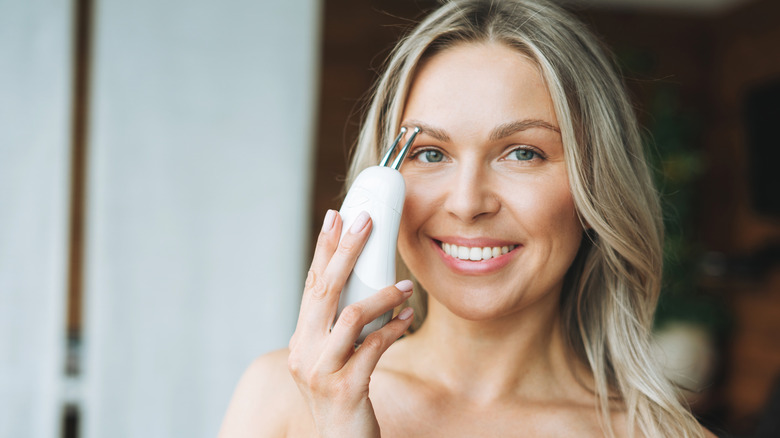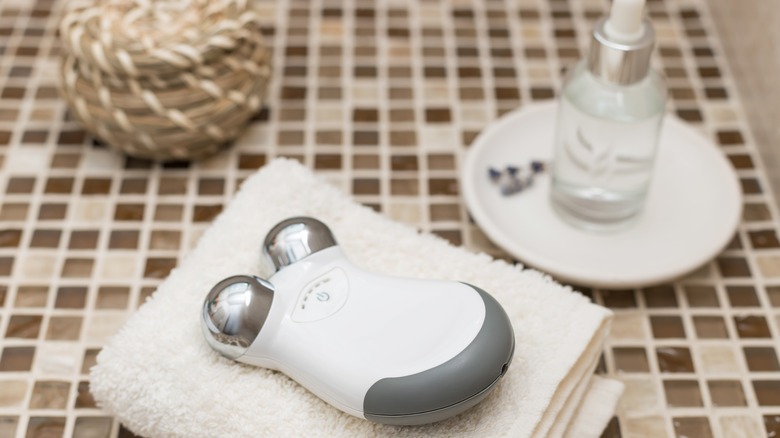Three Hacks To Make Your Microcurrent Device Work Better
The measures we take to maintain youthful-looking skin are pretty insane, from investing in pricey antiaging moisturizers to frequent visits to a cosmetic dermatologist to get injectables like Botox and fillers. Remember the Clarisonic brush? It was at its peak when Oprah Winfrey included it among her favorite things, but sadly the hype didn't last (via The New York Times). If you have the funds, the sky is the limit when it comes to devoting time and energy to skincare.
There was a time when you could only get specialized facial treatments from professionals because nobody else had those fancy skincare tools at home. But times have changed, and with the right devices, you can do them yourself in the comfort of your own home. If you are a regular at a spa, you must have seen an array of splurge-worthy treatments, and one of them is called microcurrent therapy. Celebrity esthetician Sarah Akram told Editorialist, "This treatment is designed to 'exercise' the facial muscles." The low electronic currents lift, tone, and firm the skin. And yes, you can use a microcurrent device at home, but to see results, you need to know a few things.
You should understand the basics of your microcurrent device
Microneedling is a treatment where you make tiny holes on your skin to stimulate collagen production, and it can cost $200-$700 at the office, but you can purchase your own microneedling roller for about $20, per Healthline. However, if you're not careful, you might hurt yourself and get an infection. When you incorrectly use a facial device or tool, you might actually end up messing up your skin even more, so it's essential to know how to use it properly. Similarly, before using an at-home microcurrent device, you need to know how it works and what it is doing to your skin.
You know it makes your skin firmer, but how does it work? Our body produces adenosine triphosphate (ATP), which helps make the collagen responsible for our skin's texture, but as we get older, our body produces less collagen (via Byrdie). Holistic skincare expert Pooja Johari, M.S., founder of 7E Wellness, told Mindbodygreen, "What we do with microcurrent is replenish and boost the ATP and therefore, the collagen and elastin." So basically, the result is younger-looking skin. Anyone who wants a little lift can use this, but Los Angeles-based celebrity aesthetician Gina Mari does not recommend this for people who are pregnant, prone to seizures, or have any electronic or metal implants in their body, per Today.
Your muscles shouldn't twitch during or after use
Now that you know how it works and what kind of results to expect, another important tidbit is how often you should use the microcurrent device. Lara Kaiser, an aesthetician in New York City, told Today, "You want to give your muscles a day off here and there." You get rest days from your workout, and you should practice the same principle while exercising your face muscles.
If you are a pro at giving yourself a microcurrent facial, you probably know how it feels and how often you should use it, but there is something that should not happen when you use low electric pulses on your skin, and that is skin twitching. Pooja Johari also told Mindbodygreen, "If it's a true microcurrent, muscles will not twitch or jump." If that happens, you should be using a weaker current. So, if your microcurrent device is giving you visible skin twitches during and after, it is not a good sign. 7E Wellness shared that twitching can result from built-up lactic acid. If that is the case, it might be best to leave it to the professionals instead of trying it at home. It is supposed to feel like a calming experience and not cause obvious physical sensations.
You should use a high-quality conductive gel with your microcurrent device
TikTok has become the bible for innovative and creative beauty products, but all of the information isn't always accurate. Today reported that some TikTokers use aloe with their microcurrent devices, which is definitely not a good idea. First, you need to get your skin ready. You should wash your face with an oil-free cleanser; Chris Luckham, education specialist at Foreo, told Harper's Bazaar, "oils actually act as a barrier to the electrical current." And, we want the device to work its antiaging magic on the skin. Most microcurrent devices come with their own gel, but you have to make sure to get the right conductive gel when you run out. Vanity Owl recommends only using water-based and oil-free products like creams, serums, and gels for alternatives.
When choosing the right conductive gel, Pooja Johari told Mindbodygreen, "You want conductive gels that are clean and don't contain any ingredients that may have long-term negative implications." These devices don't come cheap, so you don't want to use whatever you find lying around because it might not work. Get yourself a high-quality microcurrent device with the right gel and enjoy what they can do for your face because they do all the heavy lifting for you.



